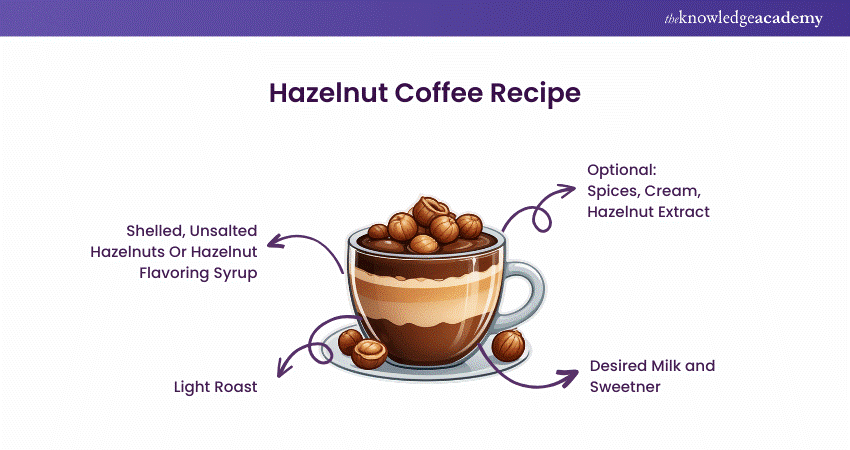We may not have the course you’re looking for. If you enquire or give us a call on 01344203999 and speak to our training experts, we may still be able to help with your training requirements.
We ensure quality, budget-alignment, and timely delivery by our expert instructors.

Nothing unites coffee enthusiasts and nut lovers quite like the delightful deliciousness of Hazelnut Coffee! Whether in its refreshingly simple brew form or its sweet, syrupy thickness, the nutty aroma of this blend is sure to transport you to the cosy atmosphere of the Alps. While coffee ups the refreshment factor, hazelnuts imbue this drink with countless health benefits, making Hazelnut Coffee the ultimate hot beverage.
This is affirmed by the fact that thanks to increased awareness about health and nutrition, the Hazelnut market is expected to grow by £1.896 billion by 2026. While this drink conjures up images of seasoned baristas at warm cafes, you can master the art of making Hazelnut Coffee just as well at home. This blog takes you on an aromatic step-by-step journey towards creating the perfect cup of Hazelnut Coffee. Let's sip in!
Table of Contents
1) A Brief History of Hazelnut Coffee
2) Hazelnut Coffee recipe
a) Ingredients
b) Tools
c) Methods
3) Benefits of Hazelnuts
4) Hazelnut Cappuccino
5) Conclusion
A Brief History of Hazelnut Coffee
Hazelnuts come from the tree Corylus Avellana, which originated in Western Asia and Europe. They first became part of organised agriculture in Scotland about 9,000 years ago. People relied on hazelnuts and other categories of nuts to sustain themselves, as meat and other dietary sources were scarce in that region.
The nut's fatty and nutritious composition kept people healthy and strong. Even after thousands of years, hazelnuts remain a dietary staple, although often consumed with little extra sugar today. So, the sugary hazelnut brew likely doesn't qualify as part of the ancient paleo diet.
A Hazelnut Coffee recipe

Nowadays, Hazelnut Coffee in café is commonly made with flavoured hazelnut syrup. While it is tasty and a staple part of most coffee lovers' routines, it comes with a lot of sugar, fat, and calories. In addition, it is also not the traditional way of making a hazelnut brew.
Ingredients
Making authentic hazelnut brew isn't hard. You might even have the supplies and ingredients necessary for making this delicious coffee. They are:
a) Lightly roasted coffee beans
b) A bag of shelled, unsalted hazelnuts: You should be able to find these at just about any grocery store, or you can order them from an online platform
c) Sweetener of choice
Tools
Here are the kitchen tools needed for this coffee recipe:
a) Coffee grinder (ideally manual coffee grinder)
b) A coffee maker of choice (ideally French press)
c) A spoon for stirring
d) A heat-safe coffee mug
Methods
While this method takes a little more time than just adding a syrup pump to a cup of coffee, the final product makes it worth it.
a) Grind and Brew Your Preferred Coffee with Hazelnuts
While using hazelnuts for a traditional Hazelnut Coffee, ensure they are shelled and unsalted. Salt neutralises the bitterness of coffee, so if you wish to avoid altering the authentic taste of the brew, refrain from adding salt.
Most of the Hazelnut flavour comes from its outer layer, so keep it intact; your drink won't have skin bits of hazelnut. Always start with a ratio of two coffee and one hazelnut, such as 2 tbsp of coffee beans and 1 tbsp of hazelnuts. You can later experiment and play around to find your best taste. Grind the beans and nuts mixture on a very coarse setting, and brew it as you would with any coffee.
b) Add in the Desired Milk, Cream, and Sweetener
Take a dairy creamer of your choice - whole milk, heavy cream or half and half. If you are vegan, use alternatives like almond milk. You don't need a lot of milk here, only 1 tbsp of either of it, or your brew may become too diluted and lose the taste of hazelnuts.
As for the sweetness, while using hazelnut flavouring, it may be sweet enough that you don't need to add more sweetener to coffee. While using real hazelnuts, try adding 1 tbsp of granulated white sugar, brown sugar, or a complimentary natural syrup that works well with a hazelnut flavour. Strawberry and raspberry syrups can bring out the coffee's nuttiness.
c) Add the Final Touch Before Serving
After you fill your glass, if you wish, top it with a small tbsp of ground cinnamon to mix two delectable aromas into one cosy blended experience and get the best notes.
Wish to make more varieties of popular coffee-based beverages? Join our course in Basic Barista Online and master a variety of popular brews!
Benefits of Hazelnuts
Today, primarily grown in Poland, the United States, Turkey, and China, Hazelnut is widely popular as an ingredient in baked goods, candy, butter spread, and coffee syrup. However, that's not the only reason why its popularity has grown as these nuts offer a lot of nutritional value. Let's take a look at the benefits that come with eating this nut:
1) Promotes heart health
2) Good for bone health
3) Regulates blood pressure
4) Reduces inflammation
5) Prevents several forms of cancer
6) Strengthens muscles
7) Nourishes skin
8) Improves blood sugar levels
All of these health benefits are due to the nutrients in the nut. Although this small snack may be higher in calories, it is packed with protein, antioxidants, omega fatty acids, vitamin E, fiber, Vitamin B6, and folate, much like the benefits of Coffee, which also provides antioxidants and essential nutrients.
Hazelnut Cappuccino
If you prefer something other than sweet, fancy coffee, a hazelnut cappuccino may be more your speed. You can make this recipe traditionally, but you can swap ingredients and steps to suit your needs.
Here are the ingredients you will need:
1) Light roast coffee beans
2) Unsalted, shelled hazelnuts
3) Milk of choice
4) Sweetener
You will also need the following equipment:
1) Coffee grinder, spice grinder, or food processor
2) Espresso machine (used in various types of coffee recipes)
3) Milk steamer or saucepan
Now that you have assembled the ingredients and equipment, follow the following instructions:
1) Grind the Beans and Brew Espresso: The first step involves grinding the nuts and coffee beans together. But keep in mind that since hazelnuts are oily when ground, you may not want to use your coffee grinder for this. A food processor, dedicated spice grinder or a strong blender should do the trick. For a cappuccino, you must have one part espresso and one part milk, though you can make the choice of single or double shot. Brew the espresso into a mug and put it aside.
2) Steam Milk: Next, you must create steamed and frothed milk. If you have a steamer on hand, you can heat your milk using about ½ cups of the milk of your choice. Otherwise, slowly heat milk on medium, in a medium saucepan stirring often. Make sure you don’t let the milk come to a boil. Once it’s hot, add half of this contents to your espresso.
3) Froth Milk: Ad for the remaining milk, slightly turn the heat up and use a low-hand mixer to beat it. Increase the speed slowly as you go until a foam-like texture appears. Add the remaining foamed milk to your cup.
Conclusion
Making a traditional Hazelnut Coffee with this delicious and straightforward recipe only requires you to have coffee, sweetener, and some shelled unsalted Hazelnut. You can get creative with your hazelnut drink after perfecting the basics of the traditional recipe.
Try different types of creams, milk, vegan alternatives, flavoured extracts, and even additional flavourings like cocoa powder. Add sweeteners like granulated white sugar or maple syrup to your coffee. There is no right or wrong way with hazelnuts; it's just your way.
Expand your practical hands-on approach to industry projects and standards with our Industry Training – Sign up now!
Frequently Asked Questions
What Does Hazelnut Coffee Taste Like?

Hazelnut Coffee tastes intensely nutty, sweetened, rich, creamy, and earthy, and it blends nicely with the bitterness of the coffee beans. The prevailing aroma is lovely, and it makes a great introduction to the coffee world for new at-home baristas.
Is Hazelnut Coffee Good for You?

Hazelnut coffee is good for you and its benefits include:
1) Improving heart health with omega-3 fatty acids
2) Strengthening the effects of oxidative stress with antioxidants.
3) Reducing cholesterol with phenolic compounds.
4) Nutrients like vitamin E and proanthocyanidins help reduce the risk of cancer.
What are the Other Resources and Offers Provided by The Knowledge Academy?

The Knowledge Academy takes global learning to new heights, offering over 3,000 online courses across 490+ locations in 190+ countries. This expansive reach ensures accessibility and convenience for learners worldwide.
Alongside our diverse Online Course Catalogue, encompassing 19 major categories, we go the extra mile by providing a plethora of free educational Online Resources like News updates, Blogs, videos, webinars, and interview questions. Tailoring learning experiences further, professionals can maximise value with customisable Course Bundles of TKA.
What is The Knowledge Pass, and How Does it Work?

The Knowledge Academy’s Knowledge Pass, a prepaid voucher, adds another layer of flexibility, allowing course bookings over a 12-month period. Join us on a journey where education knows no bounds.
What are the Related Courses and Blogs Provided by The Knowledge Academy?

The Knowledge Academy offers various Industry Courses, including the Basic Barista Course and the Product Management Course. These courses cater to different skill levels, providing comprehensive insights into Coffee.
Our Business Skills Blogs cover a range of topics related to Coffee, offering valuable resources, best practices, and industry insights. Whether you are a beginner or looking to advance your Barista skills, The Knowledge Academy's diverse courses and informative blogs have got you covered.
Upcoming Business Skills Resources Batches & Dates
Date
 Basic Barista Course
Basic Barista Course
Fri 25th Apr 2025
Fri 20th Jun 2025
Fri 29th Aug 2025
Fri 31st Oct 2025
Fri 19th Dec 2025






 Top Rated Course
Top Rated Course



 If you wish to make any changes to your course, please
If you wish to make any changes to your course, please


